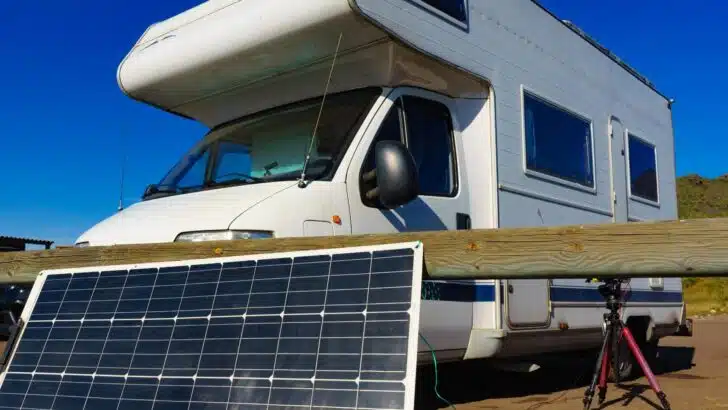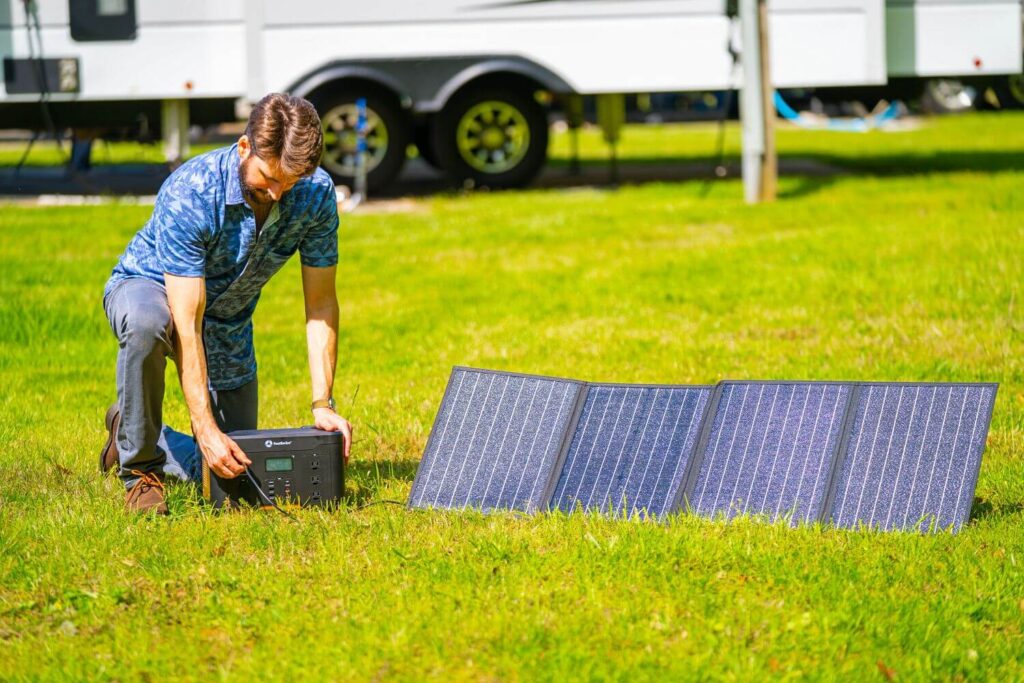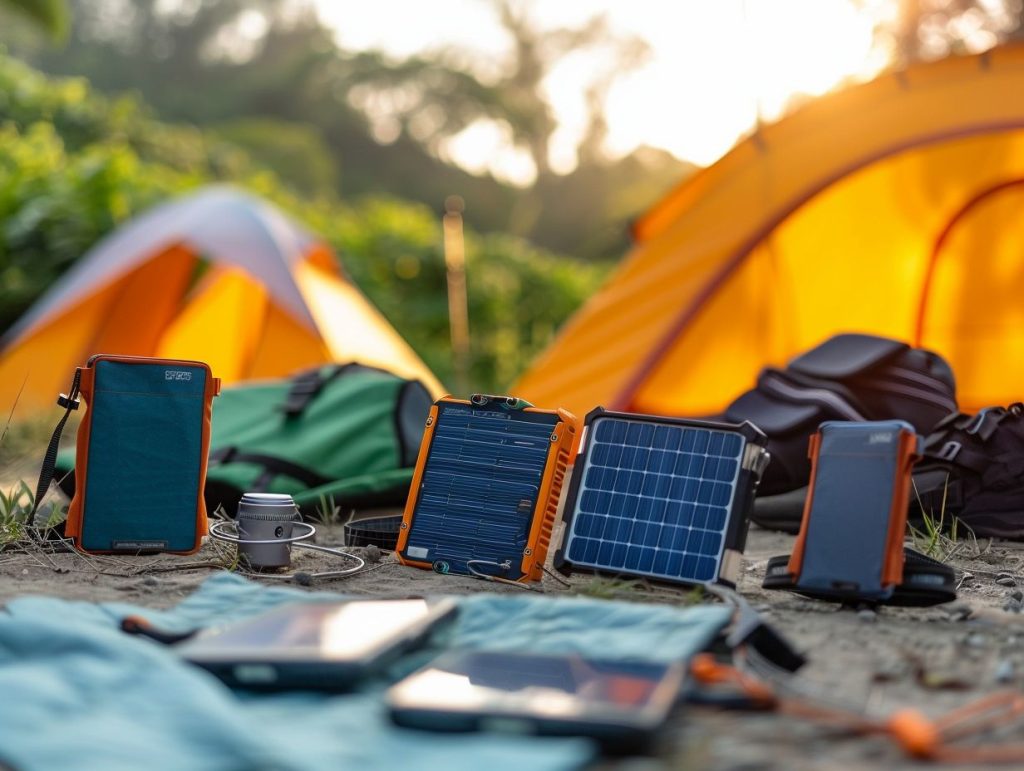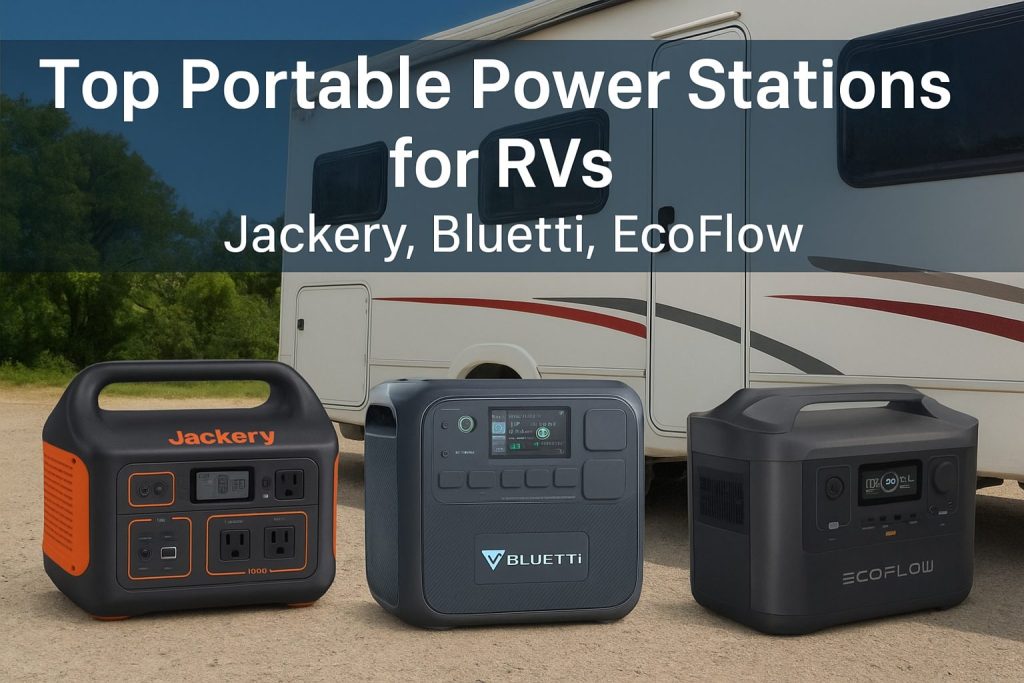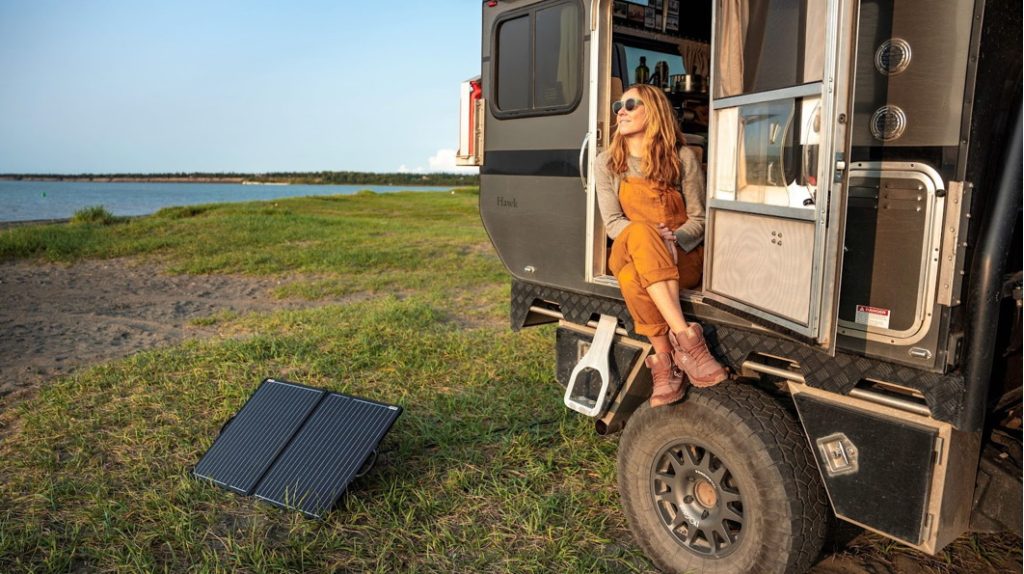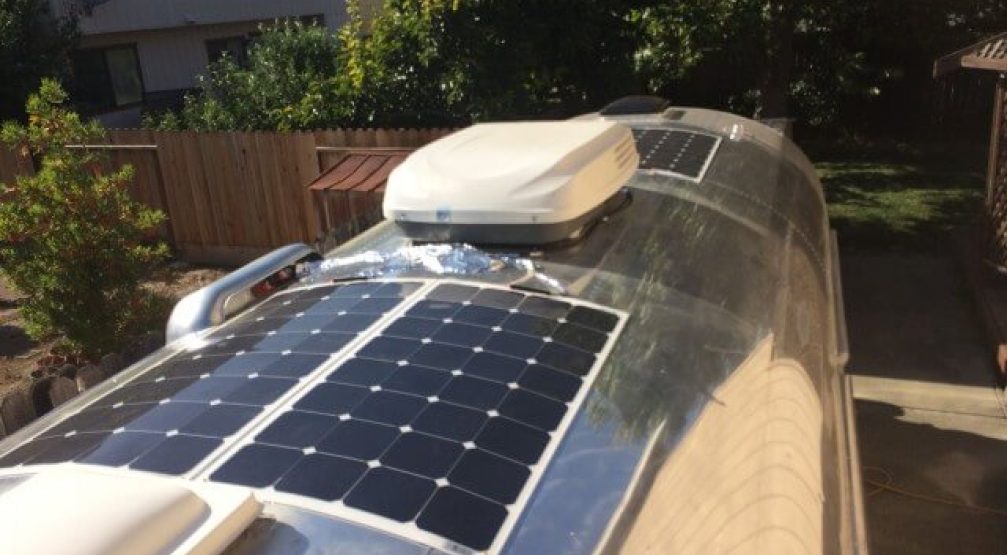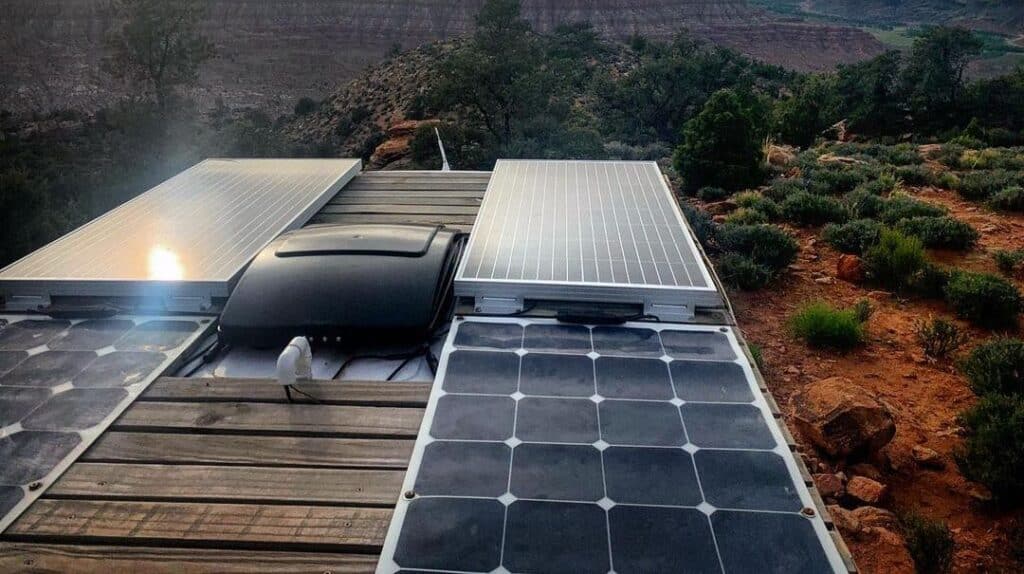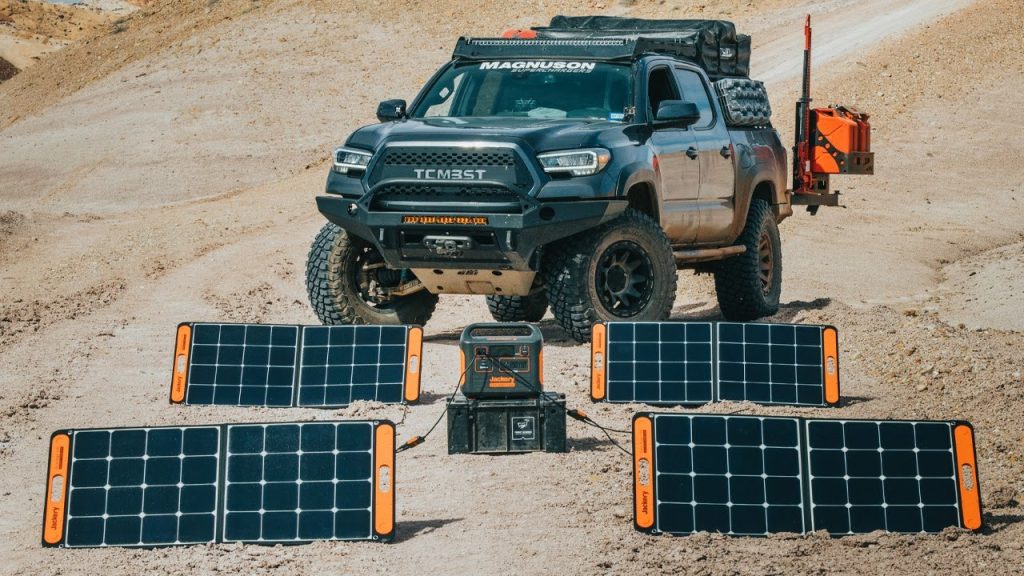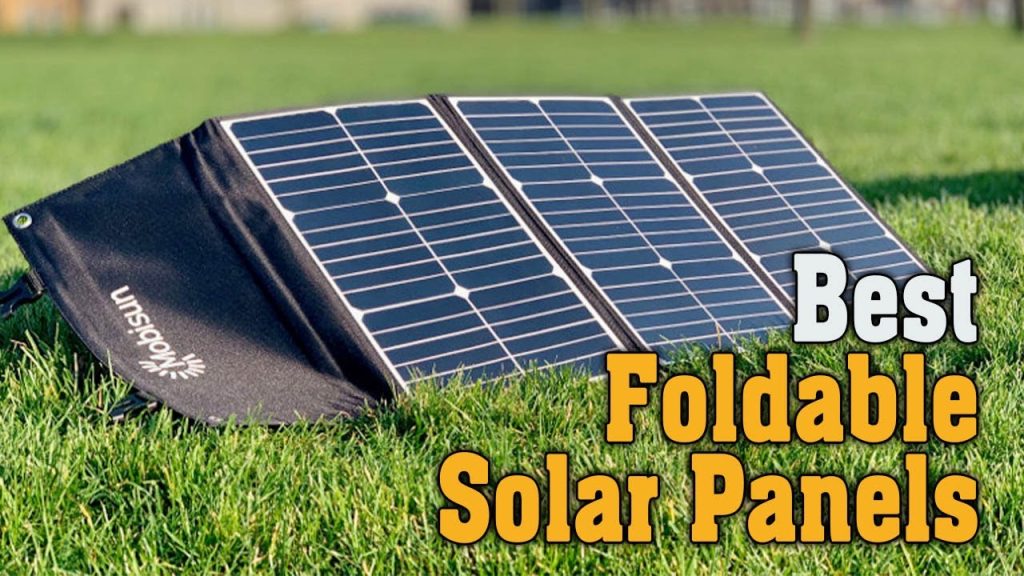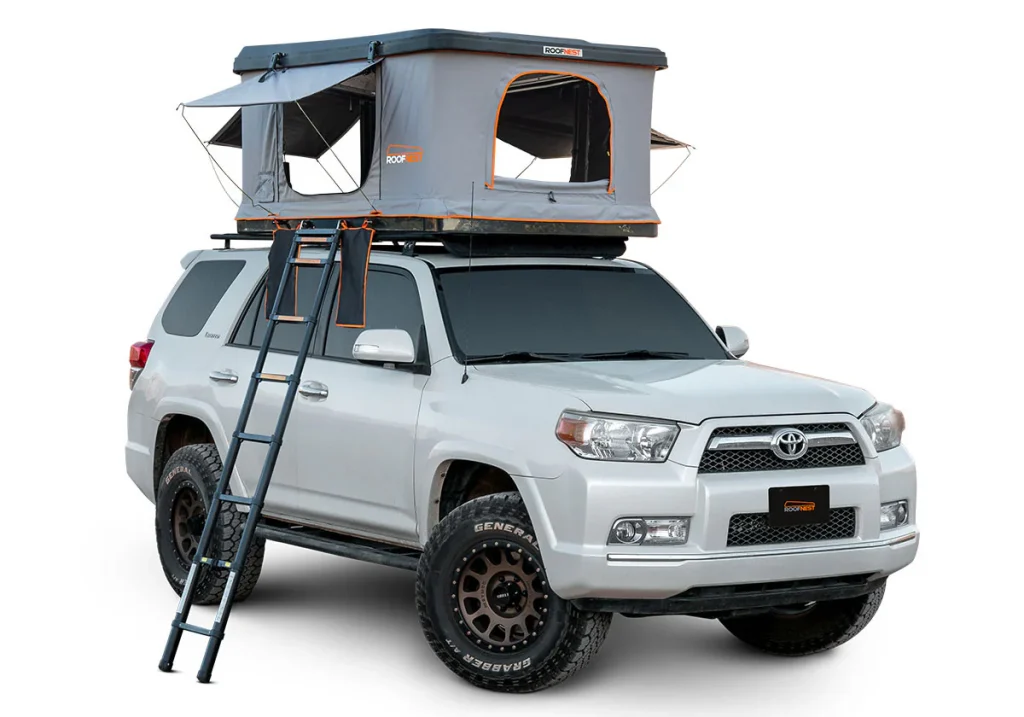As RV travel continues to rise in popularity, more adventurers are turning to portable solar panels to power their off-grid lifestyle. These compact, efficient energy solutions have become an essential companion for campers, overlanders, and full-time RV dwellers who crave freedom from noisy generators and unreliable campground hookups.
Portable solar panels transform sunlight into clean, renewable energy that powers everything from lights and fans to fridges and laptops inside your RV. For travelers who love boondocking or dry camping, solar panels are the backbone of off-grid capability, keeping batteries charged even miles away from civilization.
By extending your battery life and reducing the need for fuel-powered generators, solar panels not only save money but also minimize environmental impact. They allow you to enjoy longer stays in remote locations, maintain quiet campsites, and reduce maintenance costs related to generator wear and tear. Simply put, portable solar panels give you energy independence — power whenever and wherever you need it.
The year 2025 brings significant innovations to the world of portable solar technology. Manufacturers have made major leaps in efficiency, weight reduction, and durability, making panels more travel-friendly and robust than ever before.
Modern solar panels now feature:
-
Higher conversion efficiency (often 23% or more), delivering more power in less space.
-
Lightweight, foldable designs that pack easily into RV storage compartments.
-
Rugged materials like ETFE coating and reinforced hinges that withstand heat, dust, and rain.
-
Smart features such as integrated MPPT charge controllers, Bluetooth monitoring, and modular connectivity for quick chaining.
These advancements mean today’s RVers can capture more solar energy with fewer panels, enjoy faster charging times, and benefit from smarter energy management systems that adapt to changing sunlight conditions.
In this comprehensive 2025 buyer’s guide, we’ve reviewed the 7 best portable solar panels designed specifically for RVs, campers, and off-grid travelers. You’ll find detailed information on each model — from Jackery and Goal Zero to Renogy, EcoFlow, Anker, and others — including key specifications, pros, cons, and real-world performance insights.
How We Picked These 7 — Criteria & Methodology
Choosing the best portable solar panels for RVs requires more than just comparing wattage. Our goal was to identify products that balance power, portability, and long-term reliability — the qualities most important for overlanders, full-time RVers, and weekend adventurers alike.
To ensure an unbiased and data-driven selection, we evaluated dozens of models using a combination of technical specifications, field testing feedback, and customer experiences. Below is an overview of the key factors and research process that guided our top 7 picks.
Selection Criteria
1. Efficiency / Conversion Rate
The first benchmark we looked at was the efficiency rating, which indicates how effectively a panel converts sunlight into usable electricity. Panels in our list generally feature monocrystalline cells with efficiencies between 21% and 24%, reflecting the latest advancements in 2025 solar technology.
Higher efficiency translates to more power from smaller surface areas, which is especially important for RV users with limited space. We also compared bifacial designs, which capture light from both sides for added output.
2. Power Output (Watt Rating) and Performance Under Partial Sun
We analyzed the rated wattage (typically 100W to 200W) and compared it with real-world performance under various light conditions. Some panels maintain impressive power delivery even on cloudy days or when partially shaded — a critical factor for RVers who camp in mixed environments. Our scoring included both lab-tested output and community-reported performance.
3. Portability: Size, Weight, and Folded Dimensions
Since RV travel demands compact and mobile equipment, we prioritized panels that offer lightweight, foldable, and easy-to-carry designs. Models under 20 lbs with integrated handles or carry cases scored higher. Folded dimensions were also considered, ensuring they fit neatly into standard RV storage compartments without consuming valuable space.
4. Durability & Weather Resistance
Outdoor gear must endure harsh conditions — from desert heat to coastal humidity. We evaluated each panel’s build quality, materials, and IP rating (water and dust resistance). The most reliable options offered IP65 or higher, with ETFE coatings, corrosion-resistant frames, and reinforced hinges designed to withstand UV exposure and travel vibrations.
5. Brand Reputation, Warranty, and Support
Brands with a proven track record in portable power solutions earned top marks. We examined each manufacturer’s customer service responsiveness, warranty terms (ranging from 12 months to 5 years), and replacement support availability. Established companies like Jackery, Goal Zero, Renogy, and EcoFlow have consistently shown strong after-sales support and product longevity.
6. Ecosystem Compatibility (Connectors & Power Station Integration)
Because RVers often mix brands for panels, power stations, and controllers, connector compatibility is essential. We verified each panel’s MC4, XT60, Anderson, or proprietary plug support and its ease of connection to popular systems from Anker, Bluetti, and EcoFlow. Products offering plug-and-play integration or flexible adapter kits scored higher.
7. Customer Reviews & Reliability in Real-World Use
User experiences provide the most honest measure of reliability. We analyzed hundreds of verified reviews across marketplaces and forums, focusing on long-term performance, heat tolerance, and transport durability. Consistent positive feedback, low failure rates, and solid field test results were key factors in our final rankings.
Sources & Research Method
To ensure credibility, our evaluations were based on:
-
Amazon and manufacturer listings: for technical data and warranty details.
-
User reviews and Q&A sections: to understand common issues, praises, and long-term reliability.
-
RV community feedback: including insights from RV forums, YouTube reviewers, and boondocking blogs that performed real-world testing.
-
Hands-on data and specifications: verified against field test reports and manufacturer documentation to ensure accuracy.
This multi-source research allowed us to cross-check marketing claims against actual user experience, ensuring only the most dependable panels made it to the list.
Caveats & Disclaimers
While we’ve done our best to ensure accuracy, there are always variables that can affect performance and user experience:
-
Variations across SKUs: Some panels have multiple versions or regional variants with slightly different specs.
-
Differences in shipped accessories: Cables, connectors, and charge controllers may differ by seller or bundle.
-
Real-world output fluctuations: Solar performance depends heavily on sunlight intensity, panel angle, geographic location, and shading conditions.
While manufacturer specs give a baseline, real-world results will always vary. Our methodology reflects both the science and the reality of using portable solar panels in the field — giving you a trustworthy guide to power your next off-grid adventure.
Quick Comparison Table
Below is a side-by-side comparison of the top 7 portable solar panels for RVs in 2025, featuring their key specifications and best-use recommendations. This table helps you quickly identify which model suits your power needs, travel style, and setup preferences.
| Rank | Model | Max Wattage | Cell Type | Efficiency (if known) | Folded Size / Dimensions | Weight | IP Rating | Best Suited For (Use Case) |
|---|---|---|---|---|---|---|---|---|
| 1 | Jackery SolarSaga 200W (Bifacial) | 200W | Bifacial Monocrystalline | ~24% (est.) | Foldable suitcase with built-in handles and stands | ~20 lbs (varies) | IP68 | Full-time RVers or overlanders needing high-output, weatherproof panels compatible with Jackery power stations. |
| 2 | Goal Zero Nomad 200 | 200W | Monocrystalline | ~22% (typical) | Foldable case with legs & hanging loops | ~20 lbs | IP65 | Ideal for travelers using Goal Zero power stations seeking rugged, plug-and-play solar power. |
| 3 | EF ECOFLOW 160W (NextGen) | 160W | Monocrystalline | ~25% (claimed) | Foldable with adjustable kickstand | ~13 lbs | IP68 | Great for compact setups or users who prioritize efficiency and portability with EcoFlow gear. |
| 4 | Renogy 200W 12V Suitcase Kit | 200W | Monocrystalline | ~21% (est.) | Foldable suitcase with Voyager controller | ~27 lbs | IP65 | RV owners who prefer a direct battery-charging solution with a built-in charge controller. |
| 5 | Renogy 200W Portable (Kickstand) | 200W | Monocrystalline | ~22% (typical) | Foldable with built-in kickstands | ~20 lbs | IP65 | Campers needing a reliable, durable all-around solar panel for power stations or 12V setups. |
| 6 | DOKIO 100W Foldable Solar Panel Kit | 100W | Monocrystalline | ~21% (typical) | Very compact, ultra-light foldable design | ~6 lbs | IP65 | Best for weekend campers or minimalists wanting a budget-friendly lightweight option. |
| 7 | Anker PS100 / SOLIX-Compatible Panel | 100W | Monocrystalline | ~23% (claimed) | Foldable with adjustable stand | ~8 lbs | IP67–IP68 | Excellent for Anker SOLIX users seeking premium build quality and portability. |
Which Kind of User This Suits Best
-
Full-Time RVers & Overlanders: The Jackery SolarSaga 200W and Goal Zero Nomad 200 stand out for their power capacity and durability. They’re perfect for those living on the road who rely heavily on renewable energy.
-
Compact Travelers & Efficiency Seekers: The EcoFlow 160W panel strikes a balance between power and size, ideal for those needing a lighter yet capable solar setup.
-
Traditional RV Battery Users: The Renogy 200W Suitcase Kit is unbeatable for direct 12V charging — plug-and-play convenience for RV batteries.
-
Balanced Power & Portability: The Renogy 200W Portable (Kickstand) is a great choice for anyone seeking reliability and flexible use between power stations and battery banks.
-
Weekend Campers & Budget Buyers: The DOKIO 100W panel offers an ultra-lightweight, affordable solution for casual off-grid trips.
-
Premium Compact Power Users: The Anker PS100/SOLIX panel provides sleek, durable performance for tech-focused travelers who value quality and integration with Anker systems.
Each of these panels caters to a different type of traveler — from full-time nomads to casual weekenders — ensuring there’s a perfect fit for every kind of RV lifestyle.
In-Depth Reviews — Top 7 Portable Solar Panels for RVs in 2025
#7 Jackery SolarSaga 200W — Foldable / Bifacial Portable Panel
 Jackery’s SolarSaga 200W is a foldable, IP68-rated bifacial portable panel engineered to pair with Jackery Explorer power stations (and compatible with other generators via adapters). It folds into a carry case and features built-in handles and stands for easy placement.
Jackery’s SolarSaga 200W is a foldable, IP68-rated bifacial portable panel engineered to pair with Jackery Explorer power stations (and compatible with other generators via adapters). It folds into a carry case and features built-in handles and stands for easy placement. Specifications
- Max Power: 200 W (Bifacial)
- Water Resistance: IP68 Rating
- Form Factor: Foldable Suitcase Style
- Features: Carry Handle & Stands
- Outputs: Jackery-Compatible MC4 or Proprietary Connectors
- Weight: See Amazon Listing for Details
Pros
- High output (200 W) good for charging large power stations quickly.
- Bifacial cells boost energy harvest when reflected light is available.
- Rugged, IP68 protection — suited for outdoor RV use.
Cons
- Designed to pair best with Jackery ecosystem — may require adapters for some power stations.
- 200 W panels are bulkier/heavier than single 100 W panels when transporting.
#6 Goal Zero Nomad 200 — Foldable 200W Portable Panel
 Goal Zero’s Nomad 200 is a foldable, monocrystalline portable solar array built to integrate with Goal Zero Yeti power stations. It folds into a case with hanging loops and fold-out legs for optimal angling. Goal Zero positions it as a rugged, travel-ready option engineered in the U.S.
Goal Zero’s Nomad 200 is a foldable, monocrystalline portable solar array built to integrate with Goal Zero Yeti power stations. It folds into a case with hanging loops and fold-out legs for optimal angling. Goal Zero positions it as a rugged, travel-ready option engineered in the U.S. Specifications
- Max Power: 200 W
- Cell Type: Monocrystalline
- Form Factor: Foldable Array
- Includes: Folding Case, Built-in Cable, Hanging Loops & Legs
- Compatibility: Goal Zero Yeti Power Stations
Pros
- Reliable brand with robust build & US engineering focus.
- Packaged for easy deployment (legs, hang loops).
Cons
- Premium price compared with generic 3rd-party foldables.
- Best value when paired with Goal Zero power stations (may need adapters for other brands).
#5 EF ECOFLOW 160W — Foldable 160W Portable Panel (NextGen)
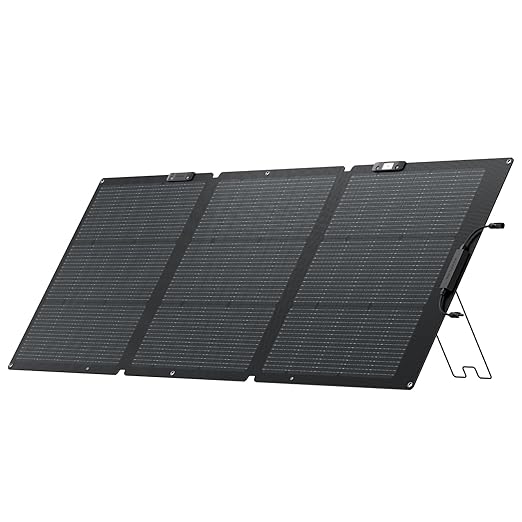 EcoFlow’s 160W foldable panel offers ~25% conversion efficiency according to the listing, with adjustable kickstand(s) and IP68 water resistance. Marketed as a NextGen portable panel to charge EcoFlow power stations fast.
EcoFlow’s 160W foldable panel offers ~25% conversion efficiency according to the listing, with adjustable kickstand(s) and IP68 water resistance. Marketed as a NextGen portable panel to charge EcoFlow power stations fast. Specifications
- Max Power: 160 W
- Conversion Efficiency: ~25% (manufacturer-claimed)
- Water Resistance: IP68 Rating
- Features: Adjustable Kickstand, Foldable Design
- Compatibility: EcoFlow Power Stations
Pros
- High cell efficiency on a compact foldable (good power-to-size)
- Designed to work seamlessly with EcoFlow power stations (fast charging)
Cons
- 160 W is less than 200 W options (slower charging for very large power stations)
- Full compatibility and max power often require using maker’s recommended cables/adapters
#4 Renogy 200W 12V Portable Solar Panels (Suitcase) — Foldable Suitcase Kit + 20A Controller
 The Renogy 200W solar suitcase (foldable panels) is a long-standing RV/off-grid favorite. The kit typically ships with a waterproof 20A Voyager charge controller and alligator clip leads — a plug-and-play style option for 12V battery charging or powering a charge controller connected to an inverter/power station.
The Renogy 200W solar suitcase (foldable panels) is a long-standing RV/off-grid favorite. The kit typically ships with a waterproof 20A Voyager charge controller and alligator clip leads — a plug-and-play style option for 12V battery charging or powering a charge controller connected to an inverter/power station. Specifications
- Max Power: 200 W (Foldable Suitcase)
- Includes: Waterproof 20A PWM Voyager Charge Controller
- Connectors: Alligator/Clamp Connectors
- Cell Type: Monocrystalline Solar Cells
- Casing: IP-Rated Protective Casing
Pros
- Kit includes a charge controller — good for direct 12V battery/RV use out of the box
- Renogy is a well-known brand in RV/van solar community with wide accessory/support ecosystem
Cons
- PWM controller included (not MPPT) in some SKUs — MPPT chargers are more efficient
- Heavier/bulkier to carry than single-panel foldables
#3 Renogy 200W Portable (Newer Foldable/Portable Listing) — IP65 / Kickstands
 Renogy also lists a modern foldable 200W portable panel SKU with kickstands and IP65 protection, marketed specifically as a power station charger and RV camping companion. (This is a separate Renogy foldable product listing from the suitcase kit above.)
Renogy also lists a modern foldable 200W portable panel SKU with kickstands and IP65 protection, marketed specifically as a power station charger and RV camping companion. (This is a separate Renogy foldable product listing from the suitcase kit above.) Specifications
- Max Power: 200 W
- Water/Dust Rating: IP65
- Form Factor: Foldable with Built-in Kickstands
- Outputs: MC4/Standard Connectors
- Use Case: Power Station Charging & RV Camping
Pros
- Purpose-built for charging portable power stations (kickstands, MC4/outputs)
- Good brand reputation and accessory support
Cons
- Product page often lists multiple variants — confirm connector type and included accessories before buying
#2 DOKIO 100W Foldable Portable Solar Panel Kit — Ultralight 100W Option
 DOKIO’s foldable 100W solar panel is a very portable, lightweight option (commonly recommended for vanlife & RV weekenders who want a compact panel to charge power stations or batteries). The listing emphasizes low weight and compact folded dimensions.
DOKIO’s foldable 100W solar panel is a very portable, lightweight option (commonly recommended for vanlife & RV weekenders who want a compact panel to charge power stations or batteries). The listing emphasizes low weight and compact folded dimensions. Specifications
- Max Power: 100 W
- Weight: Very Light (~6 lb for common 100W model)
- Form Factor: Compact Folded Dimensions
- Includes: Often sold with small charge controller option
- Features: Multiple output ports available
Pros
- Extremely portable and easy to stow in an RV storage compartment
- Affordable compared with larger brand panels
Cons
- Lower output (100 W) — will charge big power stations slowly compared with 160–200 W panels
- Build quality and long-term durability vary by seller/sku — verify seller ratings and warranty
#1 Anker (PS100 / SOLIX-compatible panels or Anker PS series)
 Anker’s PS100 (and related SOLIX-compatible panels) offer up to ~23% conversion efficiency, an adjustable multi-angle stand, and IP67/IP68 water resistance on some SKUs. Anker markets these panels as highly portable and engineered for fast charging of Anker SOLIX power stations (but generally compatible with other stations via the right adapter).
Anker’s PS100 (and related SOLIX-compatible panels) offer up to ~23% conversion efficiency, an adjustable multi-angle stand, and IP67/IP68 water resistance on some SKUs. Anker markets these panels as highly portable and engineered for fast charging of Anker SOLIX power stations (but generally compatible with other stations via the right adapter). Specifications
- Typical Max Power: ~100 W (PS100)
- Conversion Efficiency: Up to ~23%
- Water Resistance: IP67/IP68 Rated
- Features: Adjustable Multi-angle Stand
- Design: Foldable for Travel
Pros
- Strong brand reputation and good build quality
- Designed for reliable compatibility with Anker SOLIX power stations; adjustable stand for better sun angle
Cons
- Single-panel 100 W output may be limiting for large power stations; you may need multiple panels
- Price can be higher than generic panels for similar specs
Buyer’s Guide — What to Consider for Portable RV Solar Panels in 2025
Choosing the best portable solar panel for your RV goes beyond just wattage. You need to evaluate how much energy you consume, the type of equipment you use, and the conditions you’ll travel in. Here’s a comprehensive breakdown of what factors truly matter in 2025.
Power Needs Assessment
Before you buy any portable solar panel, you must first determine how much electricity your RV consumes in a day. Every device — from your lights and fridge to your phone charger — draws power.
How to estimate daily watt-hour consumption in an RV:
-
List all appliances you use in a typical day — lights, fans, water pump, fridge, phone/laptop chargers, etc.
-
Check their power rating (Watts), usually printed on a label or in the user manual.
-
Estimate usage hours per day for each item.
-
Multiply power × hours to get watt-hours (Wh).
-
Example: A 60W laptop charger used for 3 hours = 180Wh.
-
-
Add all watt-hour values together to find your daily total.
A typical RV setup consumes 1,000–2,500 Wh per day, depending on how energy-efficient your appliances are.
Matching panel output to battery/power station size:
-
To recharge a 1,000Wh power station in one day, you’d need roughly 200W–300W of solar capacity under good sunlight (assuming 5 peak sun hours/day).
-
If you use lead-acid or lithium RV batteries, ensure your charge controller and inverter can handle your panel’s voltage and current output.
-
Consider extra wattage (20–30% buffer) to compensate for cloudy weather and system losses.
Efficiency & Technology Trends
Solar efficiency defines how well panels convert sunlight into usable power — and it’s where the biggest advancements have occurred in 2025.
Types of solar technologies:
-
Monocrystalline: The gold standard for portable panels. High efficiency (22–25%) and compact size make them ideal for RV setups.
-
Bifacial panels: Capture sunlight from both sides, increasing energy yield by 10–30%. Excellent for ground or angled setups where light reflects off surfaces.
-
Flexible panels: Lightweight and curve-friendly but less durable. Ideal for RV roofs with limited mounting options.
-
Multi-junction panels: Emerging tech combining multiple layers to push efficiency past 26%, though still pricey and rare in 2025 consumer models.
What efficiency % is realistic in 2025:
Most top portable solar panels for RVs offer 20–25% efficiency, striking a balance between cost, portability, and performance.
Portability & Packaging
Portability is a defining feature for RV solar panels. You’ll want something powerful yet manageable when packing or setting up camp.
Key factors to evaluate:
-
Weight: A 100W panel typically weighs 6–10 lbs, while 200W suitcase panels can exceed 20 lbs. Check your RV’s cargo weight limit.
-
Folded dimensions: Compact foldable panels are easier to stow in limited storage spaces.
-
Handles and cases: Built-in handles, zippered pouches, and padded carrying cases improve usability and longevity.
-
Setup convenience: Look for kickstands, adjustable legs, and magnetic hinges for quick deployment and optimal tilt toward the sun.
Durability & Weather Resistance
Your panels will face sun, wind, dust, and rain. Durability is non-negotiable for RV travelers.
Understanding IP ratings:
-
IP65: Resistant to water jets and dust — suitable for most RV environments.
-
IP67: Protected against temporary immersion — good for rainy regions.
-
IP68: Fully waterproof and dustproof — ideal for extreme off-road and marine applications.
Material quality considerations:
-
ETFE coatings: Resist UV degradation and scratching better than PET.
-
Tempered glass: Provides rigidity for suitcase-style panels.
-
Fabric stitching and frame design: Affect how well foldable panels survive constant packing and unfolding.
-
Shock resistance: Look for rugged frames or corner guards to absorb vibrations from travel.
Connectivity & Ecosystem Compatibility
Your solar panel is only as good as its ability to connect to your system efficiently.
Common connectors:
-
MC4: Industry standard for secure, weatherproof connections.
-
Anderson: Often used for power stations and high-current setups.
-
XT60 or 8mm: Common in EcoFlow, Jackery, and Goal Zero power stations.
-
Proprietary plugs: Found in brand-specific systems (verify compatibility before purchasing).
Adapters & wiring losses:
-
Use shorter, thicker cables to minimize voltage drop.
-
Parallel connections increase current, while series connections raise voltage — choose based on your charge controller’s limits.
Matching to your existing setup:
-
Always verify the panel voltage range (Vmp) matches your power station or controller’s input rating.
-
Use MC4-to-adapter cables for cross-brand compatibility.
Charge Controllers & System Integration
Solar panels need a charge controller to safely charge batteries or power stations.
PWM vs MPPT:
-
PWM (Pulse Width Modulation): Cheaper but less efficient; suitable for low-power setups under 100W.
-
MPPT (Maximum Power Point Tracking): 20–30% more efficient and better for variable light conditions — recommended for RV solar systems in 2025.
Inclusion check:
Some portable panel kits (like Renogy’s suitcase) include controllers; others (like Jackery or EcoFlow) rely on built-in controllers within the power station.
Sizing your controller properly:
-
Ensure its current rating (Amps) exceeds your panel’s maximum output.
-
Provide at least 25% voltage headroom to prevent overload under peak sunlight conditions.
Real-World Output & Loss Factors
Even the most efficient panel won’t perform perfectly under real-world conditions.
Common factors that reduce output:
-
Temperature: High heat reduces efficiency by 0.4–0.5% per °C above 25°C.
-
Shading: Even small shadows can drastically cut power in series-connected panels.
-
Tilt & orientation: Flat panels produce 10–20% less energy than properly angled ones.
-
Degradation: Expect a 0.5–1% efficiency loss per year over long-term use.
-
Cable losses: Poor-quality or long cables can drop voltage — always use heavy-gauge wire.
-
Mismatch losses: Mixing different panel types or wattages reduces overall efficiency.
Warranty, Support & Brand Reputation
Long-term reliability matters when you’re hundreds of miles from a repair shop.
Typical warranty periods:
-
Most portable panels offer 2–5 years product warranty and 10–25 years on power output retention.
Customer service & replacement support:
-
Choose brands with proven after-sales support — Jackery, Renogy, EcoFlow, Goal Zero, Anker — all known for responsive service and spare parts availability.
-
Check Amazon reviews for feedback on warranty claims and build quality over time.
Cost vs Value Considerations
The cheapest panel isn’t always the best investment. Look for balance between price, efficiency, and lifespan.
Price-per-watt comparison:
-
Budget panels: ~$0.80–$1.20 per watt (DOKIO, generic brands)
-
Mid-range: ~$1.20–$1.80 per watt (Renogy, EcoFlow)
-
Premium: $2.00+ per watt (Jackery, Goal Zero, Anker)
Long-term ROI:
-
A 200W portable panel can offset hundreds of dollars in generator fuel costs annually, especially for full-time RV travelers.
-
Durable panels with higher efficiency yield better lifetime energy generation, saving more over time.
When to pay extra:
-
If you travel frequently, camp off-grid, or depend on solar as your primary power source, investing in IP68 protection, bifacial tech, and MPPT integration is worth it.
Installation & Usage Tips for RVers
Even the most advanced solar panel won’t deliver peak performance unless it’s installed and used correctly. For RV owners, smart installation practices and daily management can maximize energy efficiency, extend system lifespan, and ensure a seamless off-grid experience.
Choosing the Right Location
Proper placement is critical for maximizing sunlight exposure.
-
Roof Mounting: Best for consistent charging while driving or parked. Ensure the roof is clean, flat, and shaded as little as possible by antennas or AC units.
-
Ground or Portable Setup: Ideal for flexible positioning. You can angle panels throughout the day to follow the sun.
-
Hybrid Approach: Combine both — roof-mounted for continuous trickle charge and portable panels for boosting power during stationary stays.
Panel Positioning and Tilt Angle
Adjusting your solar panels’ angle helps capture maximum sunlight.
-
Flat Mounts: Convenient but less efficient during winter or cloudy days.
-
Tilting Mounts: Increase energy capture by 10–25%.
-
Rule of Thumb: Angle panels equal to your latitude for optimal year-round performance.
-
Re-adjust every few months to match seasonal sun paths.
Wiring and Connections
Proper wiring ensures safety and efficient energy transfer.
-
Use MC4 connectors for universal compatibility and waterproof protection.
-
Avoid long cable runs, which cause voltage drops — keep wires as short as possible.
-
Use thick-gauge cables (10 AWG or 12 AWG) to minimize losses.
-
Always double-check polarity before connecting to your controller or battery.
If you’re using multiple panels, decide between:
-
Series Connection: Increases voltage, ideal for long cable runs and MPPT controllers.
-
Parallel Connection: Increases amperage, better for shaded areas or PWM controllers.
Integrating with Power Systems
Whether you use a solar generator or a battery bank, integration is key:
-
With Portable Power Stations: Most modern power stations (like EcoFlow, Jackery, or Bluetti) come with MC4 or XT60 ports. Use manufacturer-approved adapters for safe connection.
-
With RV Battery Banks: Install an MPPT charge controller between the panel and battery to regulate voltage and prevent overcharging.
-
Inverter Connection: Ensure your inverter wattage exceeds your peak load demand.
Always fuse your connections and use circuit breakers for added protection.
Maintenance & Cleaning
Even durable panels lose efficiency if dirty or damaged.
-
Wipe dust, pollen, or grime regularly with a soft microfiber cloth and mild soapy water.
-
Inspect cables and connectors every few weeks for corrosion or wear.
-
Avoid abrasive cleaners or high-pressure water sprays that could damage the protective coating.
-
After long trips, check for loose mounts or cracked frames.
Maximizing Output on the Road
-
Track the Sun: Reposition portable panels every 2–3 hours for optimal exposure.
-
Monitor Energy Production: Many solar kits and power stations include Bluetooth or app-based tracking.
-
Avoid Shade: Even partial shading (like from a tree branch) can reduce total output by up to 30–50%.
-
Use Reflective Surfaces: For bifacial panels, reflective surfaces beneath can improve efficiency.
Safety Precautions
-
Always disconnect panels before adjusting wiring.
-
Avoid touching connectors with wet hands.
-
Store panels in a cool, dry place when not in use.
-
If mounting on the roof, ensure panels are secured with UV-resistant brackets and lock-tight bolts to withstand highway vibration.
Seasonal and Climate Adjustments
Different environments demand different care:
-
Winter: Brush off snow; consider a steeper tilt to shed buildup.
-
Summer: Allow air circulation beneath panels to prevent overheating.
-
Coastal Regions: Rinse with freshwater periodically to remove salt residues.
For long-term storage, disconnect the system and store panels at room temperature in their carrying cases.
Troubleshooting Common Issues
| Issue | Possible Cause | Solution |
|---|---|---|
| Low charging speed | Shading, dirt, or loose cable | Clean panel, check connections |
| Battery not charging | Faulty controller or wrong polarity | Inspect wiring, replace controller |
| Panel overheating | Poor ventilation | Raise or tilt panel for airflow |
| Voltage fluctuation | Mixed panel types | Use identical panels in series/parallel |
Pro Tips from Experienced RVers
-
Use a solar watt meter to test real-time output.
-
Label cables and ports for quick setup and teardown.
-
Carry spare fuses, connectors, and zip ties.
-
Combine solar with a generator or alternator charger for hybrid backup power.
Maintenance & Troubleshooting (Long-Term Care Guide)
Owning a portable solar panel system for your RV is an investment that can last for years—if maintained properly. Regular upkeep ensures optimal performance, reduces wear, and helps you spot small issues before they become costly problems. Here’s how to keep your RV solar setup in top shape long-term.
Routine Inspection Checklist
Monthly Checks
-
Inspect panel surfaces for cracks, scratches, or discoloration.
-
Check connectors and cables for fraying, rust, or loose joints.
-
Monitor output voltage and amperage with a watt meter or built-in app.
-
Ensure mounting hardware (brackets, bolts, hinges) is tight and vibration-free.
Quarterly Checks
-
Clean the solar cells and frames to remove grime or pollen.
-
Inspect the charge controller for proper operation — verify LEDs or app signals indicate normal function.
-
Test battery voltage and ensure it’s charging/discharging within normal ranges.
Annual Checks
-
Examine seals and gaskets for UV degradation or brittleness.
-
Recalibrate your monitoring system if output readings seem inconsistent.
-
Replace damaged cables or connectors before they cause voltage losses or shorts.
Cleaning Best Practices
Dirt, dust, and grime can reduce solar efficiency by up to 25%. Proper cleaning helps maintain full power output.
Step-by-Step Cleaning:
-
Disconnect the panel from your RV system before cleaning.
-
Rinse gently with lukewarm water to remove loose dust.
-
Use a soft microfiber cloth or sponge with mild soap.
-
Avoid harsh chemicals, ammonia-based cleaners, or abrasive pads.
-
Dry with a lint-free towel or let air dry completely before reconnecting.
Pro Tip:
In desert or beach environments, clean more frequently — salt and sand can corrode connectors and etch glass surfaces.
Protecting Against Environmental Damage
Solar panels are built tough, but constant exposure to the elements can shorten their lifespan if ignored.
UV & Heat Protection
-
Use ETFE-coated or tempered-glass panels for better UV resistance.
-
Ensure panels have airflow underneath to prevent overheating (which reduces efficiency).
-
Avoid long-term exposure to direct heat sources or enclosed hot storage spaces.
Rain & Moisture
-
Panels rated IP65–IP68 resist most rain and splashes, but don’t submerge them.
-
Dry connectors before storage to prevent corrosion.
-
Apply dielectric grease to terminals to improve waterproofing.
Travel Vibration & Impact
-
Use foam padding or rubber mounts to absorb road vibrations.
-
Check for frame warping or cracked glass after bumpy rides.
-
Store foldable panels in their original carrying cases when not in use.
Electrical System Care
Batteries
-
Keep lithium batteries charged above 30% when in storage.
-
Avoid full discharges (below 10%) to extend battery cycle life.
-
Store at room temperature and disconnect if unused for months.
Charge Controllers
-
Use only MPPT controllers rated for your panel’s voltage and current.
-
Keep vents and heat sinks dust-free to avoid overheating.
-
Update firmware (if supported) for accurate solar tracking and monitoring.
Inverters
-
Clean vents with compressed air every few months.
-
Check grounding and ensure no water or condensation enters terminals.
Storage During Off-Season
When your RV is not in use for extended periods, proper storage keeps your system ready for the next trip.
-
Disconnect panels from all power components.
-
Store in a dry, temperature-controlled environment.
-
Avoid stacking heavy items on top of flexible or folding panels.
-
Recharge your battery every 2–3 months to maintain health.
Troubleshooting Common Issues
| Problem | Possible Cause | Solution |
|---|---|---|
| Low or no output | Dirty panel, shading, bad connection | Clean panels, inspect connectors |
| Controller not charging | Polarity reversed, faulty fuse | Check wiring, replace fuse |
| Voltage drop | Cable too long or thin | Use thicker cables, shorten distance |
| Overheating | Poor ventilation | Improve airflow or relocate panel |
| Uneven charging | Mismatched panels | Use identical panels or a separate controller |
| Battery overcharge | Wrong controller type | Replace PWM with MPPT |
| Flickering inverter | Loose connections or overload | Tighten terminals, reduce load |
Monitoring Performance Over Time
Use monitoring systems to track your panel’s long-term efficiency.
-
Solar Apps & Bluetooth Monitors: Track wattage, voltage, and charging history.
-
Performance Logs: Record average daily output; sudden drops indicate issues.
-
Degradation Check: Expect about 0.5–1% efficiency loss per year — more if panels are exposed to harsh climates.
Pro Tip:
If your panel consistently produces 15–20% less than its rated output (under full sun), it may be time for a warranty claim or replacement.
Warranty & Support Essentials
-
Most reputable brands offer 5–10 years of material warranty and 20–25 years of performance warranty (typically guaranteeing 80% efficiency after 25 years).
-
Keep receipts, serial numbers, and installation photos for warranty claims.
-
Contact the manufacturer before attempting DIY repairs, as unauthorized modifications can void warranties.
Extending System Lifespan
To make your investment last:
-
Use high-quality connectors (MC4, Anderson) with weatherproof seals.
-
Keep panels cool and shaded during storage.
-
Refrain from over-tightening mounts — allow slight flex for heat expansion.
-
Replace minor parts (like cables or brackets) regularly to prevent cascading failures.
When to Replace or Upgrade
It might be time to upgrade your portable RV solar system if:
-
Your energy demand has increased (more appliances, bigger battery).
-
The panel’s output has dropped significantly.
-
Newer models offer 30%+ higher efficiency or lighter foldable designs.
Upgrading ensures you stay future-ready with improved portability, connectivity, and power output.
Final Thoughts
Portable solar panels have become an essential part of modern RV travel — offering energy independence, sustainability, and cost savings for years to come. As technology continues to evolve in 2025, newer models provide higher efficiency, improved portability, and greater durability than ever before.
Whether you’re a weekend camper or a full-time RVer, investing in one of the best portable solar panels for RVs can transform your experience — keeping your essentials powered, your batteries full, and your journey worry-free.
Before purchasing, always evaluate your energy needs, portability preferences, and system compatibility. A little planning ensures your solar setup performs efficiently across all adventures.
FAQs
1. How many watts of solar panels do I need for my RV?
Most RVers find that 200–400 watts of solar power is sufficient for lights, a fridge, fans, and charging small devices. Larger systems (600W+) are ideal for running appliances like microwaves or TVs.
2. Can I use portable solar panels while driving?
Yes, if panels are roof-mounted securely. However, for safety, portable folding panels should only be deployed when parked.
3. What’s the difference between monocrystalline and polycrystalline panels?
Monocrystalline panels are more efficient and compact, ideal for RVs. Polycrystalline panels are cheaper but slightly less efficient.
4. Do I need a charge controller?
Absolutely. A PWM or MPPT charge controller regulates voltage and prevents battery overcharging. MPPT models are recommended for better efficiency.
5. Can portable solar panels power an RV air conditioner?
Not directly — air conditioners consume too much energy. You’d need a large solar array (1,000W+) and a sizable battery bank or generator backup.
6. How long do portable solar panels last?
High-quality panels can last 20–25 years, with minimal efficiency loss (about 0.5–1% per year) if properly maintained.
7. Are portable panels weatherproof?
Most are rated IP65–IP68, meaning they can handle rain, dust, and splashes — but should never be submerged in water.
8. What’s the best way to store panels when not in use?
Keep them in a dry, cool place in their carrying case. Avoid stacking heavy objects on top, and recharge your batteries every few months.
Read More: Best Pop-Up Roof Tents for Quick Setup

